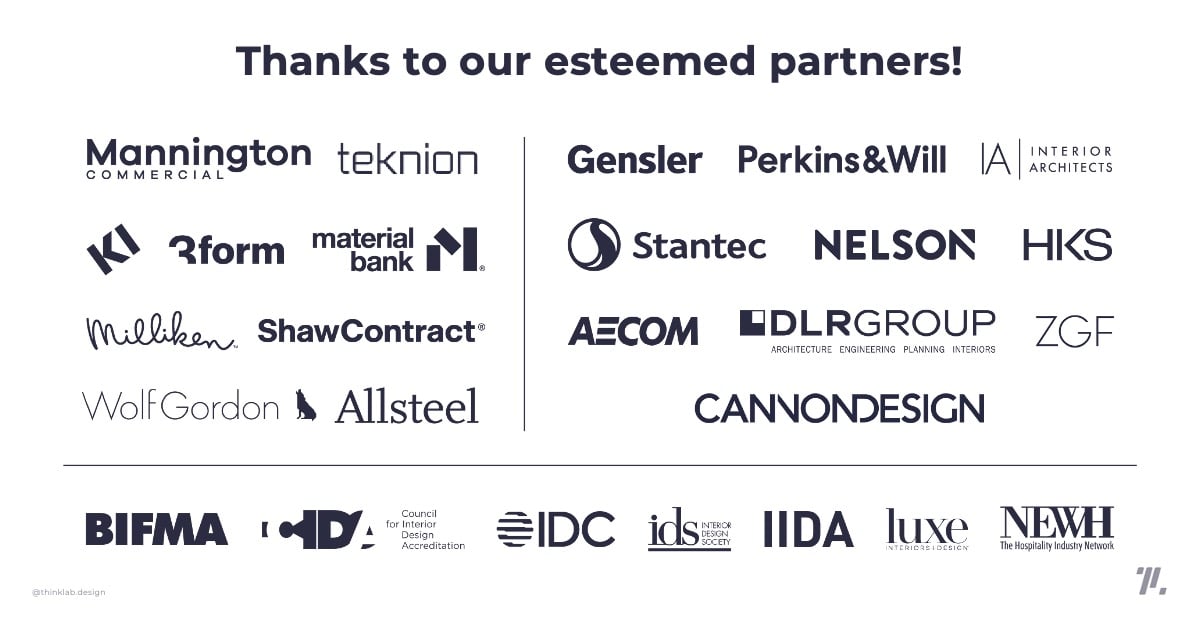Unlocking Gen Z’s Potential to Impact the Future of Work
How to attract, retain, and connect with Gen Z using the latest design industry data.

- Chapter I: Introduction to the Research
- Chapter II: Design Hackathon: The Method Behind The Magic
- Chapter III: 5 Core Challenges For Recruiting, Retaining, And Connecting Across Generations
- Chapter IV: Challenge 1: Creating Cohesive Culture In A Hybrid Workplace
- Chapter V: Challenge 2: Sparking Creativity In An Increasingly Digital Era
- Chapter VI Challenge 3: Building Relationships Across Generations With Less Face Time
- Chapter VII Challenge 4: Harnessing The Loyalty of Younger Generations
- Chapter VIII Challenge 5: Mentoring While Juggling Day Jobs
- Chapter lX Want More? You're In Luck!
Introduction to the Research
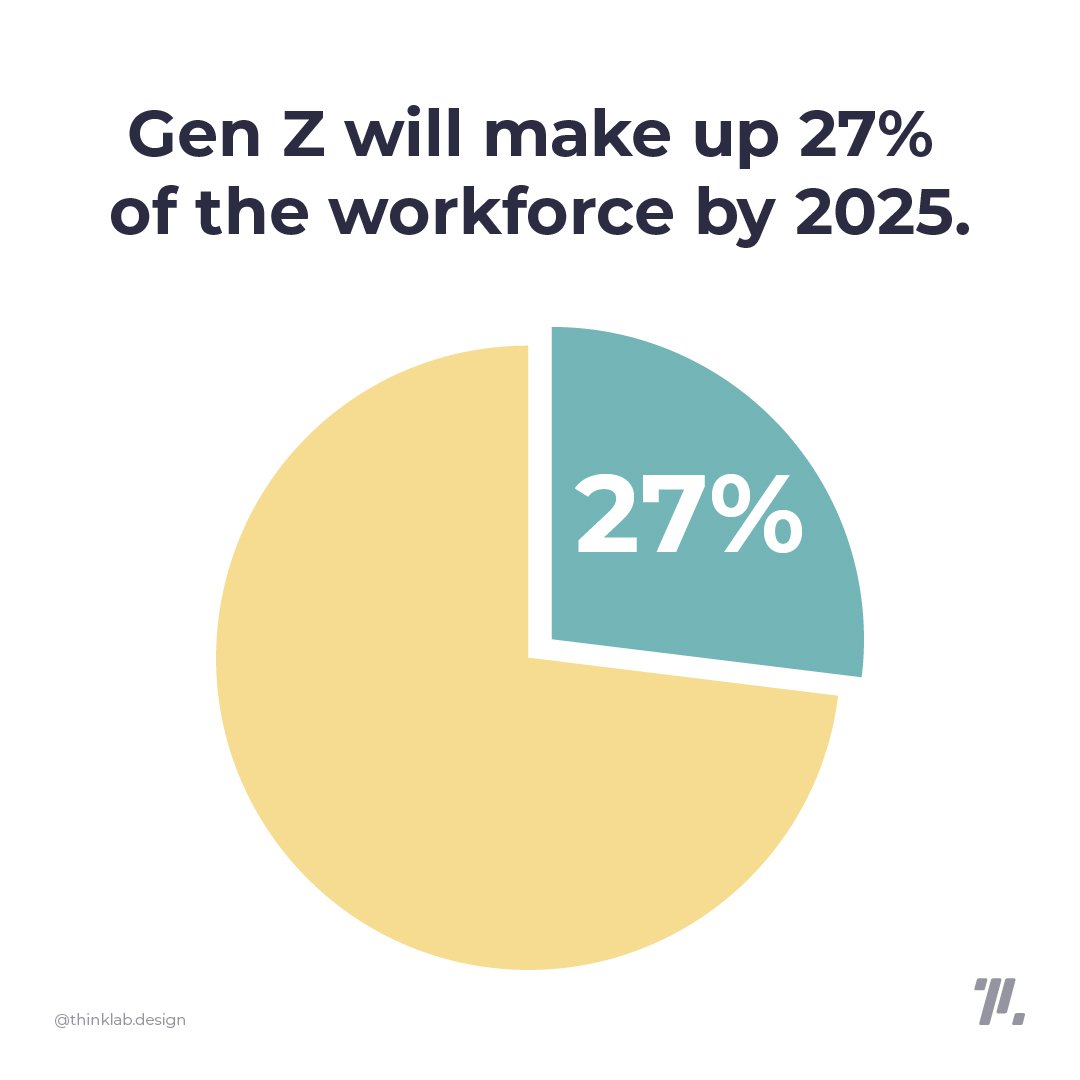
Impact on the Industry
Gen will make up 27% of the workforce by 2025. That might not sound like a lot, but when you combine them with millennials, it means more than half of the workforce will be made up of these younger generations in less than two years.
And Gen Zers bring with them some new expectations.
GenZ's Potential to Transform the Design Industry
One of the defining characteristics that differentiate Gen Zers from older generations is that they’re the first “digital natives” — those who have grown up with computers, tablets, cell phones, and social media. Simply put, most don’t know a life that isn’t intertwined seamlessly with technology.
So, it’s only natural that this fast-typin’, TikTokin’ group is going to drive fundamental shifts in “the way things have always been done.” Gen Zers have new ways to evaluate your brand, new ideas about how and where and why they want to work, and new ideas about what connection looks like in a world where they are connected to everyone all the time.
Now, take this new generational mindset, and couple it with the fact that many interior design firms have also been struggling to find the right talent lately. From 2019 to 2022, the top 200 interior design firms laid off nearly 50 percent of their staff, according to our INTERIOR DESIGN Giants of Design research. And while firms have recovered in terms of sheer numbers, we all know that onboarding takes time, and they’ve said that finding the right fit hasn’t been easy. We have a twofold problem.
Interior design firms need the right talent,
and young talent are looking for a different type of experience
than their parents were.
So, if you are a design firm looking to recruit, retain, and connect with the next generation — and let’s be honest, who isn’t? — our latest research will help you make meaningful shifts to your approach to future-proof your business.
Let’s explore how.
- If you’re a leader at an A&D firm: How do you recruit and retain the right talent for your business in today’s economic climate? How do you empower team members at all levels?
- If you’re an employee at an A&D firm: How do you bond with cross-generational teams in an increasingly hybrid world, across geographic boundaries, and amid vastly different communication styles?
- If you’re a manufacturer who calls on A&D: How do you build relationships in a hybrid world and with a new generation of specifiers?
The Design Hackathon Process
To begin tackling a big, hairy problem like this one, you need a process. Each year, ThinkLab leverages a formal design-thinking process (which we call a “design hackathon”) to unpack the design industry’s biggest, hairiest challenges. This culture challenge ranked at the top of the list of issues to investigate, so in 2023, we did just that.
We decided to look to Gen Z as the arrow to our future to understand how to create a culture of retention. To do this, we partnered with manufacturing sponsors, industry associations, and the top 10 A&D firms in the U.S., so as to tap into as many cross-functional resources as possible. Our research methodology included a nationwide survey of 1,800 architects and designers – as well as 20+ hours of focus groups spent with leaders from the top 10 INTERIOR DESIGN Giants of Design firms to understand the biggest challenges to their business.
Then, we engaged in 20 more hours exploring fresh ideas to solve those challenges with the Gen Z designers. Our goal was to identify gaps in mindsets and pinpoint solutions to fill those gaps.
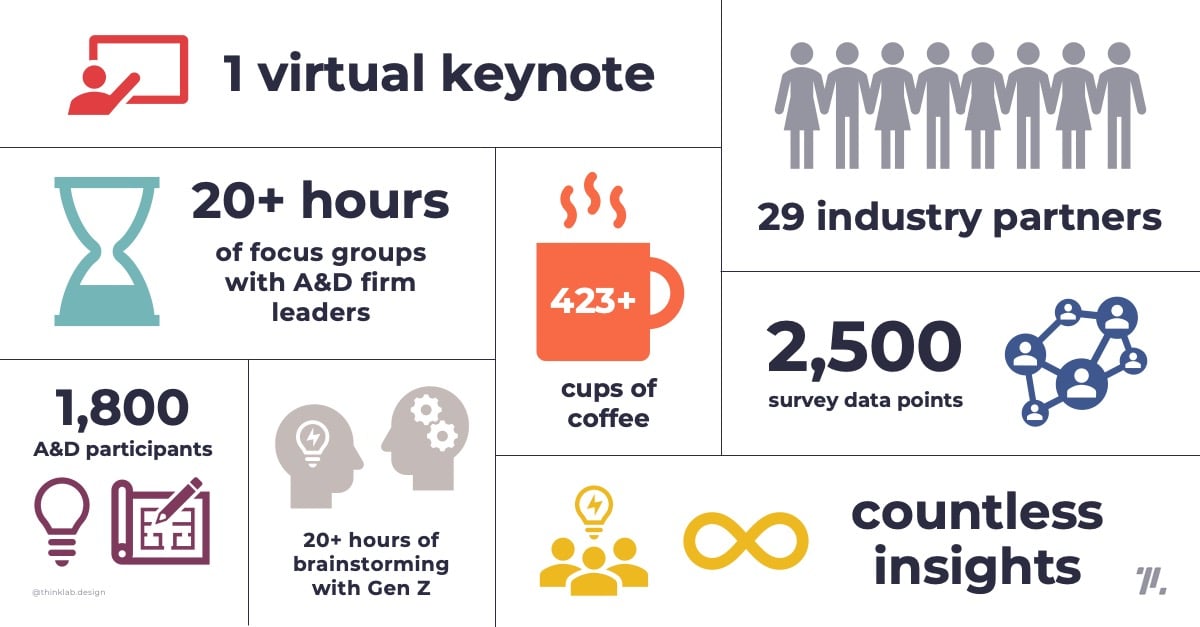
We know that news of a generational study is sometimes met with eye rolls. At their worst, these kind of studies traffic in mass generalizations or offensive stereotypes and put labels where labels have no place. We get it. So what was behind our choice to conduct a generational study in the first place?
- Most generational studies look to generations as stereotypes.
- But we shifted our view to looking at generations as prototypes.
- And in doing this, we uncovered some arrows to our future.
Let us explain.
5 Core Challenges For Recruiting, Retaining, And Connecting Across Generations
As we conducted design industry research with A&D firm leaders from the top 10 A&D design firms across the country, five key challenges emerged.
- It’s hard to create a cohesive culture in a hybrid workplace.
- It’s hard to spark creativity in an increasingly digital era.
- It’s hard to build relationships across generations without as much face time.
- It’s hard to harness the loyalty of younger generations today.
- It’s harder than ever for managers to mentor while juggling their day jobs. They’re burnt out.
When we surveyed designers across the country on these five challenges and then compared each generation, we expected to see a consistent trajectory in the trend line. But actually, the pendulum swings back, and what you’ll see is that our data frequently follows a trajectory some call “the boomerfication of Gen Z.” The more we studied the nuances, the more our “arrow” to the future started to look more and more like a “boomer-ang” (pun intended).
Gen Z has definitely helped form trend lines to our future, but our data suggests that Gen Zers are not as different from other generations as we thought.
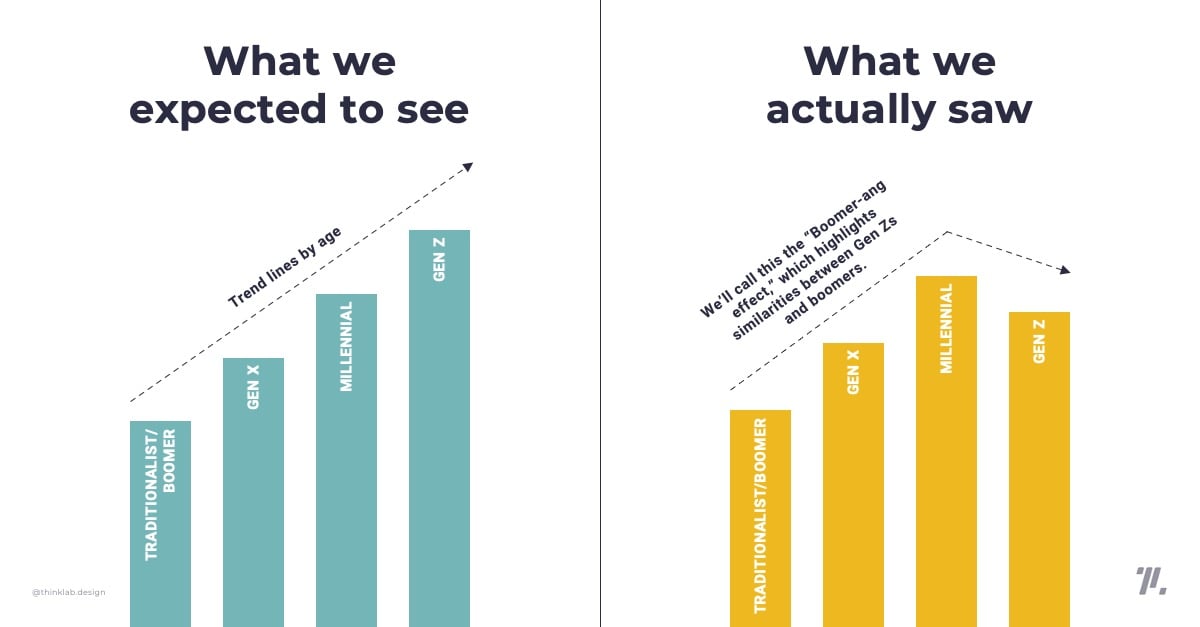
Challenge 1: Creating Cohesive Culture In A Hybrid Workplace
In the past, the office was the place culture was naturally built. Now that most of the world — design professionals included — works in a hybrid fashion, it has become much more challenging to create a cohesive culture. What we need to recognize now is that the office is only one of many tools in today’s culture tool kit.
Our biggest insight on culture revealed:
- According to Gallup, only 2 in 10 workers feel connected to their organization’s culture.
- However, according to data drawn from ThinkLab’s hackathon survey, 8 out of 10 people in the design industry feel connected to their company’s culture.
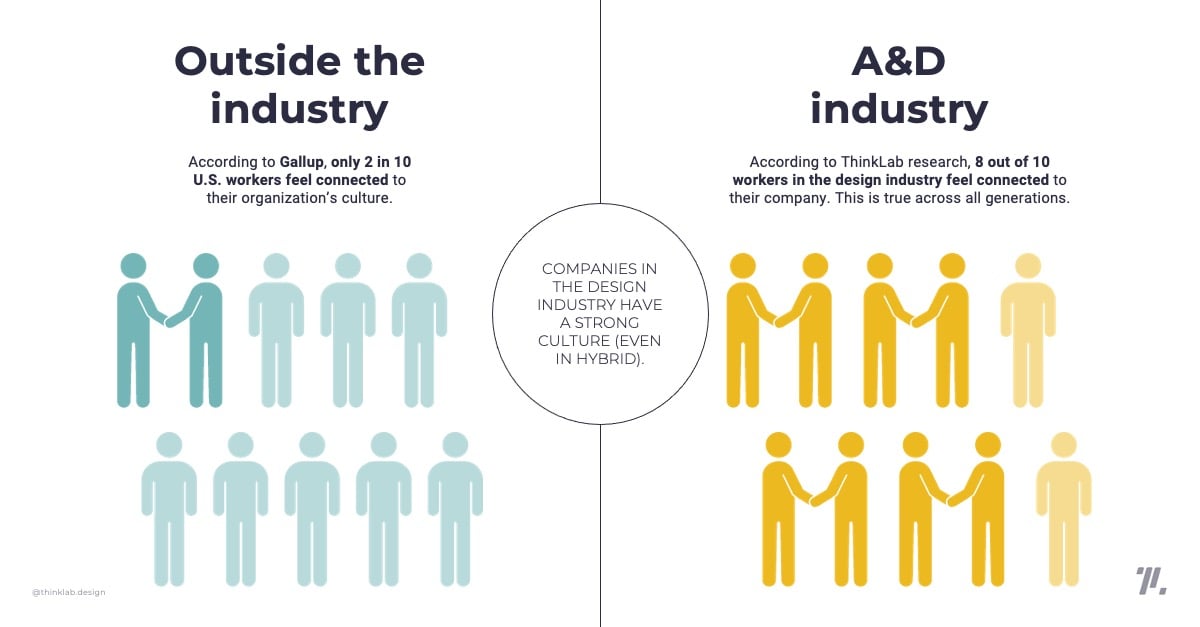
Recreate “The Hang”
Our Gen Z participants brainstormed with us to create ways to help them feel more engaged. One of those ways is to recreate what Gen Zers call “The Hang.” The idea is to build virtual spaces through an in-office messenger channel (like Slack) that recapture the watercooler vibe. These digital spaces facilitate casual conversations that allow personal bonds to form outside of tackling the day’s to-do list.
Want more? The full survey results provides answers to the following questions:
- Do Gen Z designers want to come to the office? (The answer may surprise you.)
- What are the most effective ways to build culture today?
Are we struggling with work-life balance in the interiors industry?
Challenge 2: Sparking Creativity In An Increasingly Digital Era
Over the course of our research, we often heard that creativity is suffering.
According to ThinkLab research, 75 percent of firms plan to remain on the hybrid spectrum, which means designers (especially the digital natives) will still work with digital design tools right at their fingertips.

It’s tempting to think we’ve been reduced to “design by Pinterest.” And no knocking Pinterest here, but has it crippled creativity?
The answer, according to Gen Z, is no.
So what is really stifling creativity?
- At the top 200 firms in the U.S. (according to INTERIOR DESIGN Giants of Design research), 80 percent of a designer’s time is billed to a client. If you work an 8-hour day — OK, a 9-hour day — that leaves 1 hour and 45 minutes for everything else: eating, non-billable meetings, the occasional bathroom break, you name it.
- Gen Z designers, who may not even be aware of this fact, still feel the time crunch. One has dubbed it “a time drought.”
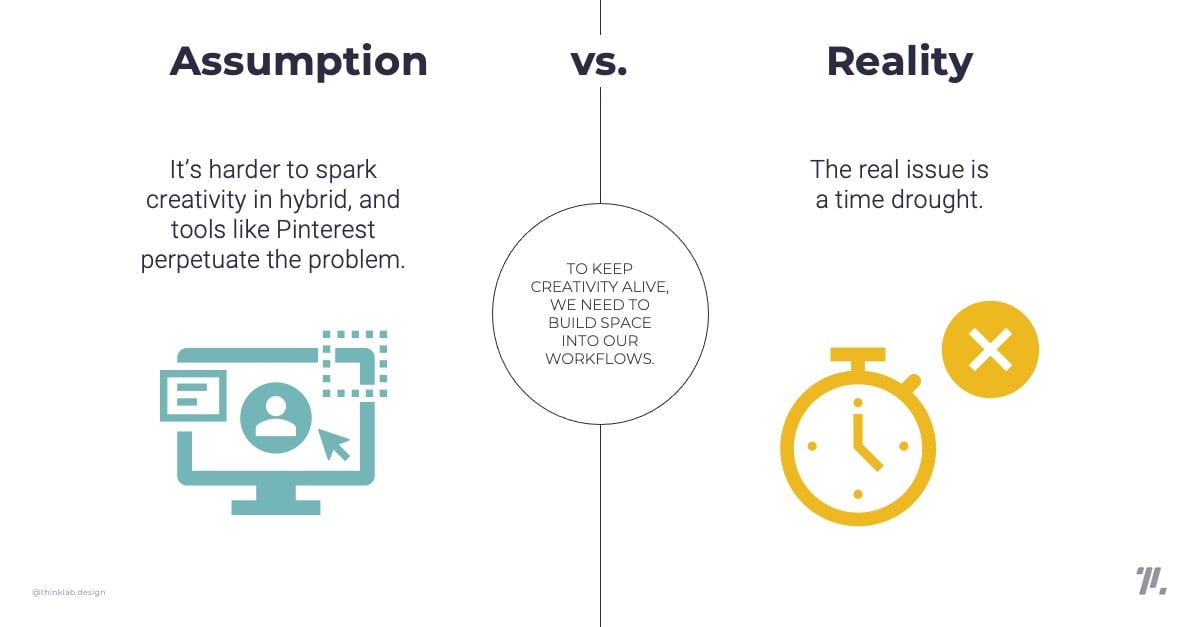
So how do we create a culture of creativity? Our research revealed a lot of ideas, but here’s just one:
Reduce Meeting Time
We’ve all laughed at the “This meeting could have been an email” meme, right? Too many (bad) meetings didn’t work IRL, and they’re not working in hybrid, either. Instead of overloading designers with meetings, figure out ways to give them (and not just Gen Zers) time for creativity instead. Appoint one person in meetings to summarize them and email notes to colleagues. Even if this only happens for a couple of meetings per week, every little bit counts.
Want more? Our full survey results reveal:
- The biggest reason creativity is suffering today
- Key insights as to how to combat challenges to innovation
Expert ideas on the best way to help spark innovation in an increasingly digital era
A&D firm leaders said a common struggle was connecting teams when they’re simply not in the office as much. And for those who call on the A&D community for a living, figuring out how to build relationships with new, incoming talent is hard. Through our design industry market research, we learned that building trust with digital natives works differently.
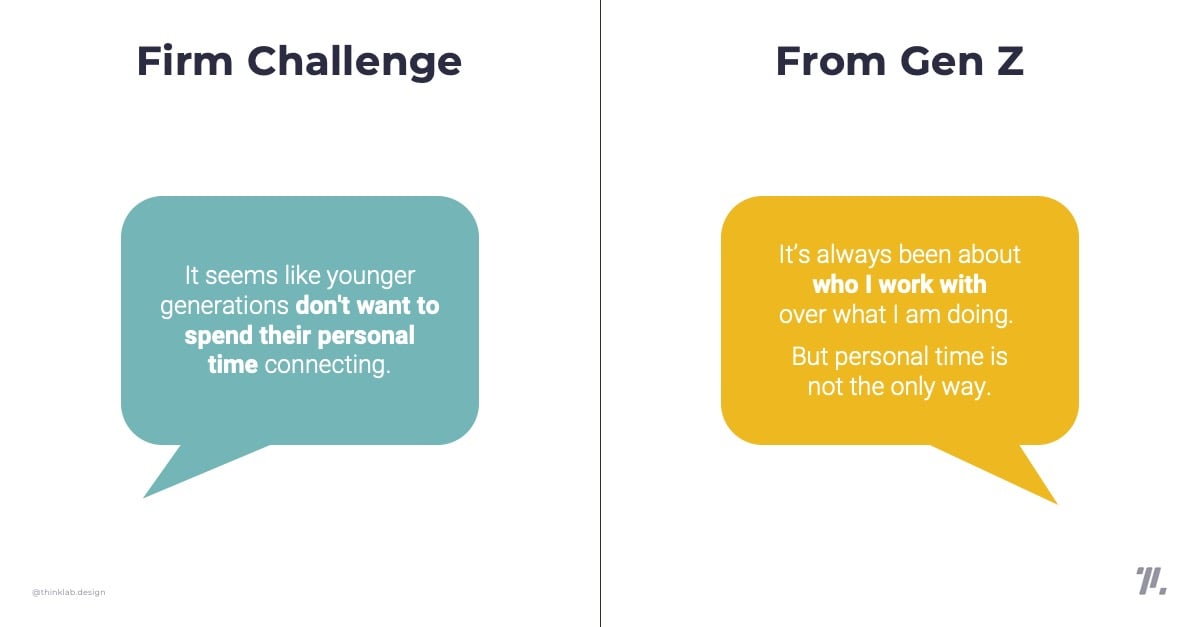
- 89% of Gen Zers think that building relationships within their company is really important.
- That said, 78% feel they can work effectively together without ever meeting in person.
So how do we effectively build relationships with next-gen talent?
Establish A Cameras-On Culture
Virtual success relies on being seen, in whatever capacity you find yourself. When you’re remote, you can still work together, cameras on and chatting along the way. It’s amazing what bonds can form virtually; you just need to create the space for work to happen communally . And that’s what Gen Z wants. So, consider carving out some time in your workday for “together time.” Set up an open meeting room where teams can just come and work, muted or not, and be virtually “together.”
Want more? Get our full survey results to explore:
- How each generation views the importance of building relationships (and spending personal time) with coworkers and industry partners — and how these views are shifting
- Insights into how to forge strong relationships and trust with Gen Z
- Differences in communication preferences by generation, along with new ideas to bridge gaps
Challenge 4: Harnessing The Loyalty of Younger Generations
- The #1 reason a designer from any generation leaves their role is higher pay, and this is true for Gen Z most of all. Jerry Maguire’s famous phrase rings true: “Show me the money!!!”
- One Gen Z participant shared this: “I want to bust this myth that Gen Z is disloyal. But antiquated mindsets of 2% raises don’t work today. We are pinged daily on LinkedIn with new job opportunities with 10% raises. Give me a reason to stay.”

So, how do we give them that reason?
Move From Succession Planning To Success Planning
Sure, money talks, so pay them what they’re worth — and, to combat the mission vs. pay struggle, focus on “success planning” instead of succession planning. In the old way, there were set career paths that guided people on how to climb the corporate ladder.
Today, it’s more about how to help Gen Zers define success for themselves, ultimately leading them to set their own career paths — which will then contribute to your organization’s success and translate into a win-win for the firm.
Want more? Our full survey results confirms (or busts) common myths, including:
- What the experts say about average tenure by generation (and what our in-industry Gen Zers perceive as “appropriate tenure”)
- How many hours Gen Z feel they are expected, as well as willing, to work
- What keeps Gen Z loyal, in order, after the money is taken care of
Challenge 5: Mentoring While Juggling Day Jobs
Among mid-level design managers these days, burnout is real. Younger designers need training, and their managers are tasked with managing shorter project timelines, remotely, with no rule book, all after a couple years of tremendous turnover. The learning by osmosis that used to happen in person is now cut in about half, at a time when there are fewer opportunities for mentorship.
- 2 out of 3 designers have a mentor. That means 1 in 3 do not.
- The #1 place Gen Zers want mentorship is in navigating the ins and outs of the industry, followed by developing communication skills.
- Their #1 concern is bothering someone to ask for help.
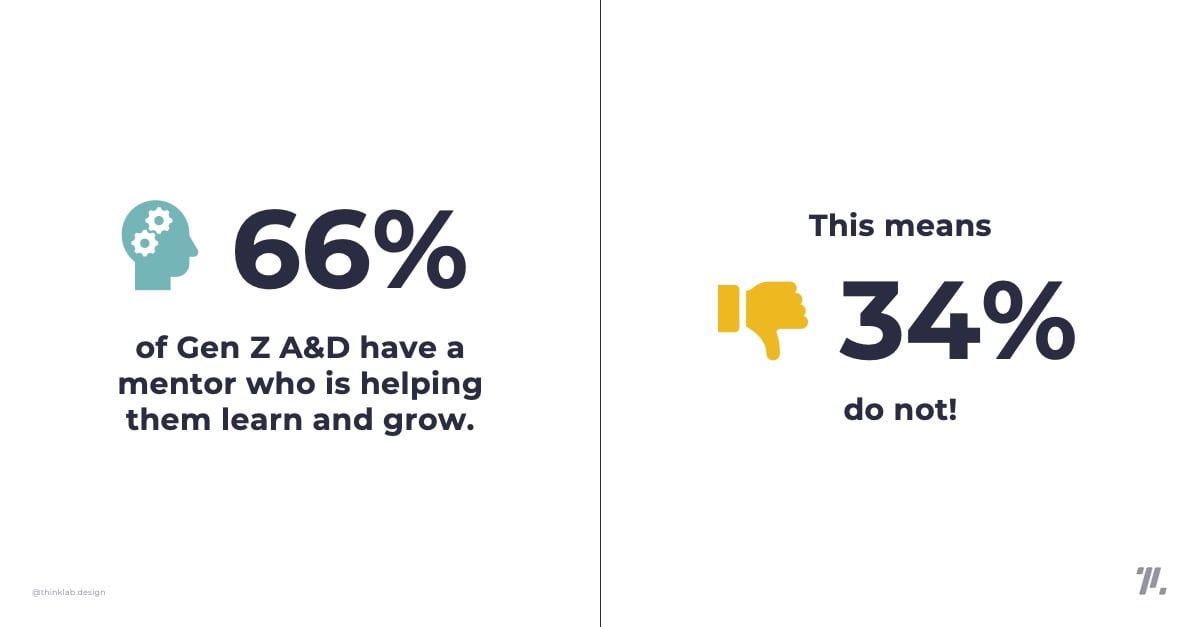
So how do we effectively mentor & upskill younger staff?
Self-Serve The Easy Stuff
Your mentors do not need to do it all. Instead, create digital systems that empower Gen Zers to learn what they can themselves, without having to ask. This is a great idea for tasks like technical skill building.
For “the hard stuff,” use your trusted expert reps to come in and give a training (or CEU), or set up times when Gen Zers can ask the harder questions that require the help of a trusted advisor. It doesn’t have to all fall on someone in your firm.
Want more? Our full survey results helps provoke new thinking around:
- How Gen Z wants to learn
- How to prevent manager burnout
- A full list of areas Gen Z wants mentorship in (and why they aren’t getting it)
Next Steps
Was this helpful? If you’re nodding yes, we invite you to consider working with our expert Gen Z Advisory Panel as the next step in supercharging your Gen Z strategy. Pick a timeslot that works best for you here and our Olga Odeide, our business strategist, will walk you through how we can help over Zoom.
Want More? You're In Luck!
While this page introduces you to the insights, this just the tip of the iceberg.
This research process would not have been possible without our esteemed Design Hackathon Advisory Council sponsors, and they’re ready to engage with you and your firm (for CEU credit, of course) to dive even deeper into what this means for your firm.
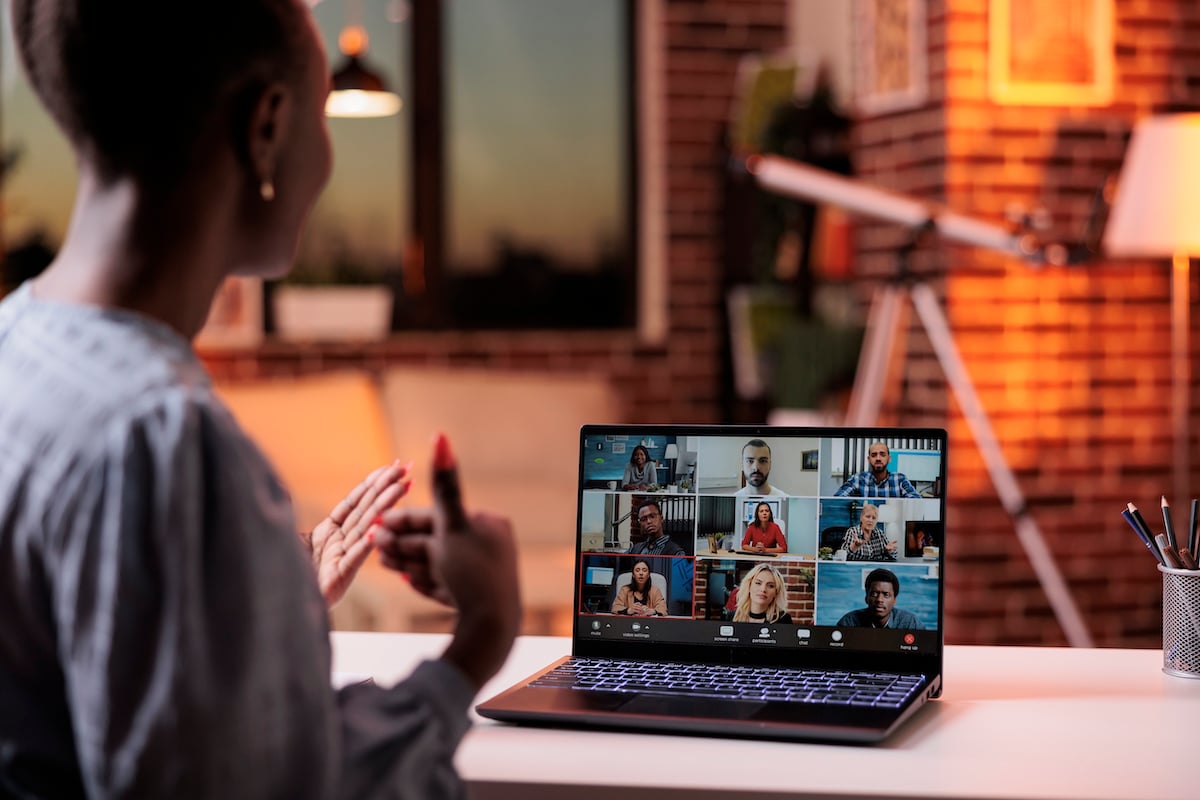
Schedule a CEU
Want all the details? Get the full data-driven insights from this research in CEU form! Get a digital version or schedule an IRL CEU presentation with our advisory council.
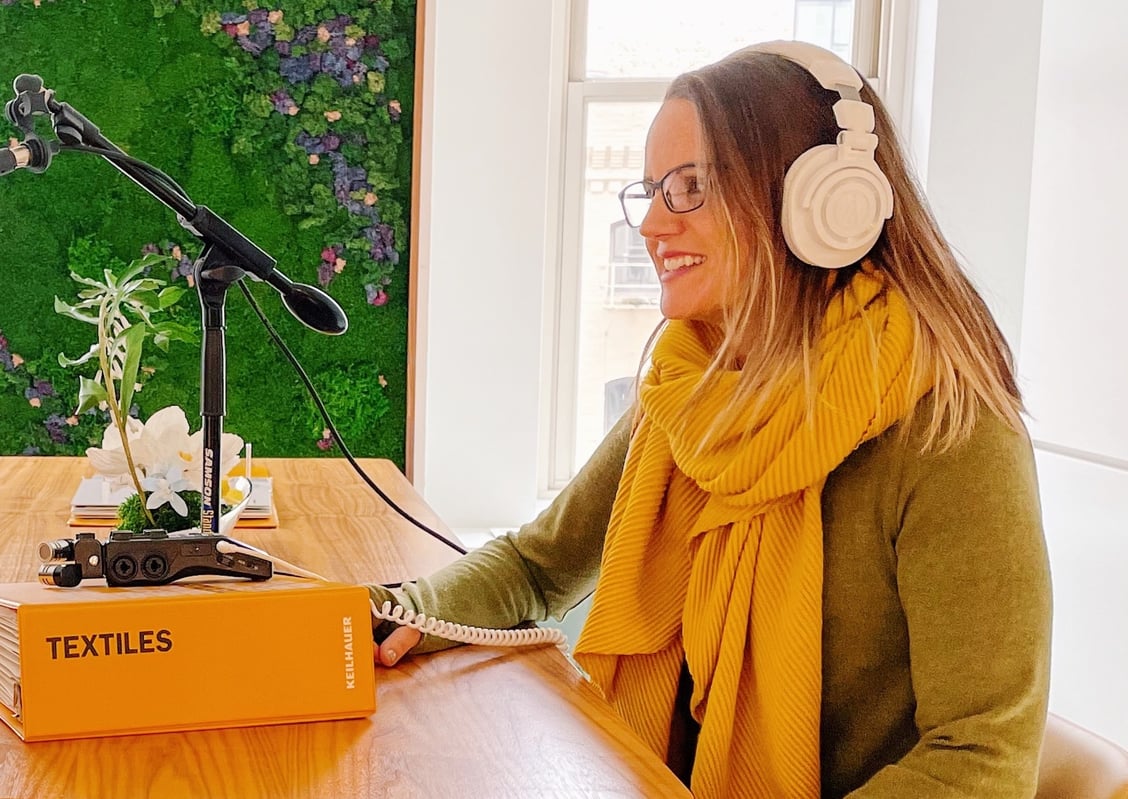
Listen to the Podcast
Want the TL:DR? Hear from ThinkLab researchers Amanda Schneider and Jessica Jenkins on their biggest "aha" moments from our survey results.
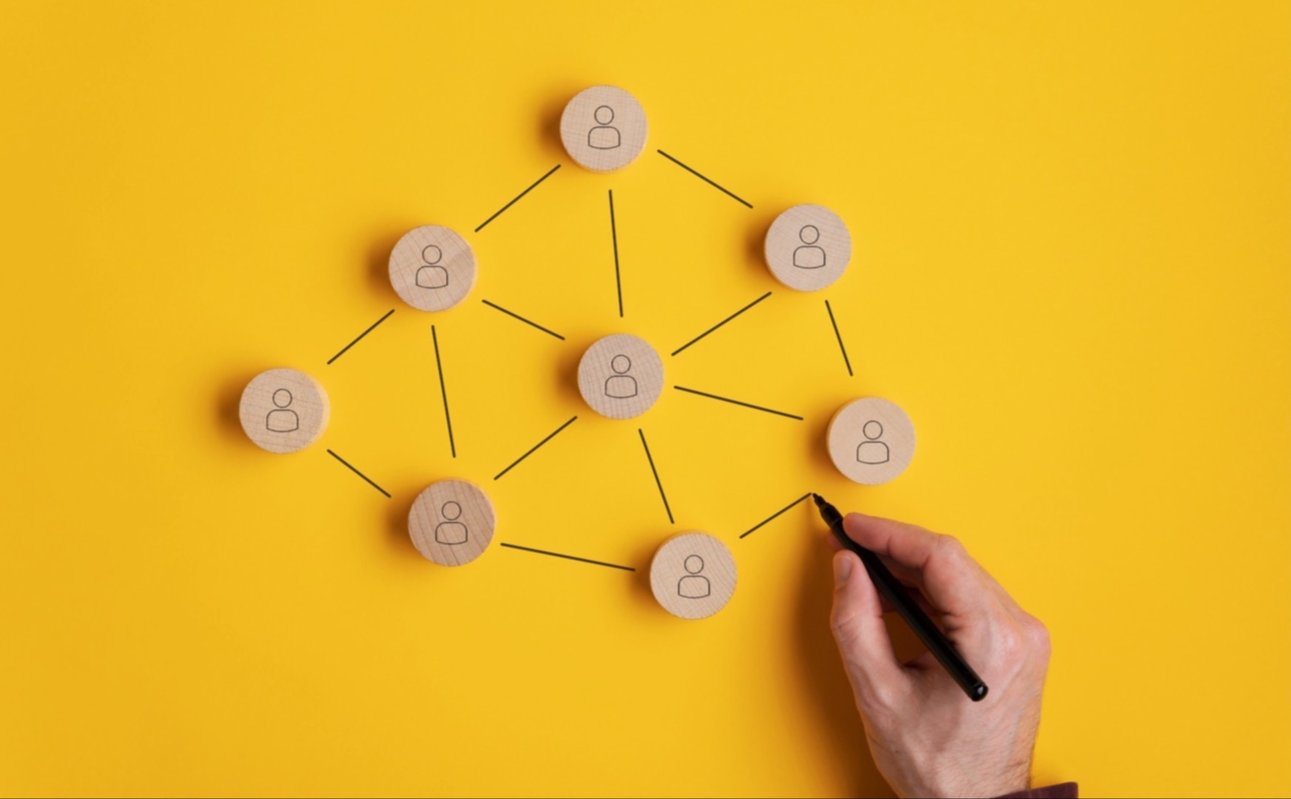
Join the Design Hackathon
Want in on our next round of generative research to grow your thought leadership, connect with industry influencers, and get valuable insights for your brand? Join us!
Get the Full Survey Results
Want all the data from our survey results? Don't miss a chance to gain access to the results, with all of the interiors industry insights you need to help drive your business forward.
Contributors:

Amanda Schneider
ThinkLab Founder & President

Erica Waayenberg
Head of Research

Allison Roon
Research & Content Development
Special thanks to our partners and participants
